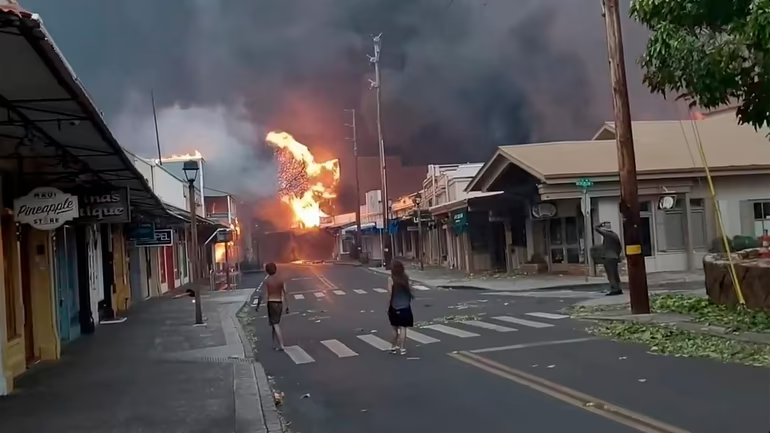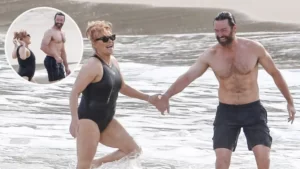
WAILUKU, Hawaii — A devastating inferno has claimed the lives of at least 36 individuals in the heart of Lahaina, Maui County. The calamitous blaze, ignited by ferocious winds from distant Hurricane Dora, caught the picturesque island of Maui off guard, leaving a trail of destruction in its wake. Once-thriving streets now bear the scars of burned-out vehicles, while historic edifices have been reduced to smoking rubble. The flames raged through the night, forcing both adults and children to take refuge in the ocean to escape the relentless onslaught.
Initial reports indicate that 271 structures have been either destroyed or severely damaged, and dozens of individuals have been injured. Firefighting crews persist in battling multiple blazes across the island, prompting officials to advise visitors to steer clear of the disaster-stricken area. Two local residents, Kamuela Kawaakoa and Iiulia Yasso, recounted their harrowing escape as they fled from encroaching flames on Tuesday. The couple and their young son fled their apartment, clutching only a change of clothes, as the surrounding vegetation ignited.
“We managed to escape just in the nick of time,” Kawaakoa shared from an evacuation shelter on Wednesday, their apartment’s fate still uncertain. Amid their escape, a senior center succumbed to the flames, and while they dialed 911, uncertainty lingered about the residents’ fate. Sirens wailed, utility poles lay strewn, and a chaotic stream of vehicles impeded their flight to safety.
Kawaakoa, who spent his formative years in the Lahaina Surf apartment building, a structure with familial ties reaching back generations, expressed his profound grief. Lahaina Town, a historic locale tracing its origins to the 1700s, has always been a cherished destination for tourists.
“It was heart-wrenching to witness my town reduced to ashes while feeling helpless,” Kawaakoa lamented.
These fires form the latest chapter in a series of climate-related calamities that have unfolded globally this summer. Experts attribute these events to the increasing influence of climate change. As winds gradually subsided over Maui, some flights resumed, offering pilots a panoramic view of the widespread devastation. Aerial footage from Lahaina showcased the ruins of numerous homes and businesses, including the iconic Front Street, once a hub of shopping and dining for tourists. Smoke-shrouded piles of debris now mark where vibrant structures once stood, while the skeletal remains of charred trees stand as solemn sentinels.
The impact extended beyond physical structures. Keith Hayashi, Superintendent of the State Department of Education, revealed that the King Kamehameha III Elementary campus suffered extensive damage, prompting the consideration of contingency plans and the potential closure of the century-old school. Despite the adversity, efforts persist to uphold regular school schedules and provide a semblance of normalcy for students.
In the midst of the chaos, the Coast Guard carried out heroic rescues, plucking 14 individuals from the water as they sought refuge from the encroaching flames and choking smoke, including two children.
Several individuals sustained critical burns and were airlifted to Straub Medical Center’s burn unit on Oahu, while Maui Memorial Medical Center received at least 20 patients. A firefighter, overcome by smoke inhalation, was hospitalized but reported in stable condition. Mayor Richard Bissen Jr. acknowledged the grim reality but lacked details about the circumstances leading to the six deaths. Although the investigation into the fires’ immediate cause has yet to begin, officials cited the lethal combination of arid conditions, low humidity, and fierce winds.
Over 2,100 individuals spent a night in evacuation centers, and approximately 2,000 travelers sought refuge at Kahului Airport following widespread flight cancellations. Plans were underway to transform the Hawaii Convention Center in Honolulu into a haven for thousands of displaced locals and tourists.
Mauro Farinelli, a resident of Lahaina, described how the winds intensified on that fateful Tuesday, seemingly conjuring the fire out of thin air.
“The flames spread with astonishing speed,” Farinelli recounted, comparing the spectacle to a blowtorch.
The forceful winds even dislodged Farinelli’s garage door and trapped his vehicle, compelling him, his wife Judit, and their dog Susi to flee to an evacuation shelter. Amidst the uncertainty, hope and trepidation mingled, as he expressed, “We’re holding onto hope, though it appears likely that everything is lost.”
The response to this catastrophe has transcended regional boundaries. President Joe Biden mobilized federal resources to aid in the ongoing response. The Hawaii National Guard deployed Chinook helicopters for firefighting and search and rescue operations on Maui.
Former President Barack Obama, a native of Hawaii, took to social media to convey his sorrow at witnessing the place of his birth in distress.
Alan Dickar, an individual with deep ties to Lahaina, reflected on the profound loss. He owns a poster gallery and multiple houses in the area, and Front Street, the heart of the devastation, held a special significance for both residents and tourists alike.
“The heart of this island lies in those central two blocks, and I fear for what remains,” Dickar lamented.
He documented the flames consuming the bustling strip before managing to escape with friends and pets. In his own words, he had lost “every significant thing” he owned but found solace in his survival.
While the inferno on the island of Hawaii’s Big Island posed a similar threat, with Mayor Mitch Roth reporting roof fires and persistent flare-ups near the Mauna Kea Resorts, it has not resulted in any reported casualties or destroyed homes.
The National Weather Service attributed the ferocious winds partly to the influence of Hurricane Dora, which remained south of the island chain.
As dawn broke on Wednesday, over 14,500 customers in Maui remained without power, and communication challenges hindered individuals from checking on the welfare of friends and family. Tiare Lawrence, desperate to reach her siblings near a gas station that had exploded in Lahaina, described the frustration of having no means to contact them.
Acting Gov. Sylvia Luke implored travelers to avoid the afflicted region, emphasizing the perilous conditions.
“This is not a safe place to be,” Luke cautioned.
Governor Josh Green, currently en route, curtailed his trip upon learning of the disaster. An emergency proclamation has been issued to address the mounting crisis.
Unlike the wildfires often encountered in the western United States, those in Hawaii typically ignite in expansive grasslands on the islands’ dry sides and are comparatively smaller in scale. The memory of a significant blaze on the Big Island in 2021, which consumed homes and forced mass evacuations, still lingers.
Iiulia Yasso, who fled with her partner Kawaakoa, conveyed a poignant truth about the impact of the tragedy: “It’s not just homes; it’s memories of a lifetime that have been lost.”
As this paradise grapples with the aftermath of this devastating fire, communities face the daunting task of rebuilding their lives, memories, and cherished places.
Disclaimer : The content of this page is written by an independent third party. earninsta does not endorse the opinions expressed. earninsta is not responsible in any way for the contents of this site. earninsta cannot guarantee or endorse them. Take all necessary steps to ensure that the information provided and any content is accurate, up-to-date, and verifiable. earninsta disclaims all express and implied warranties relating to this report or its content.






